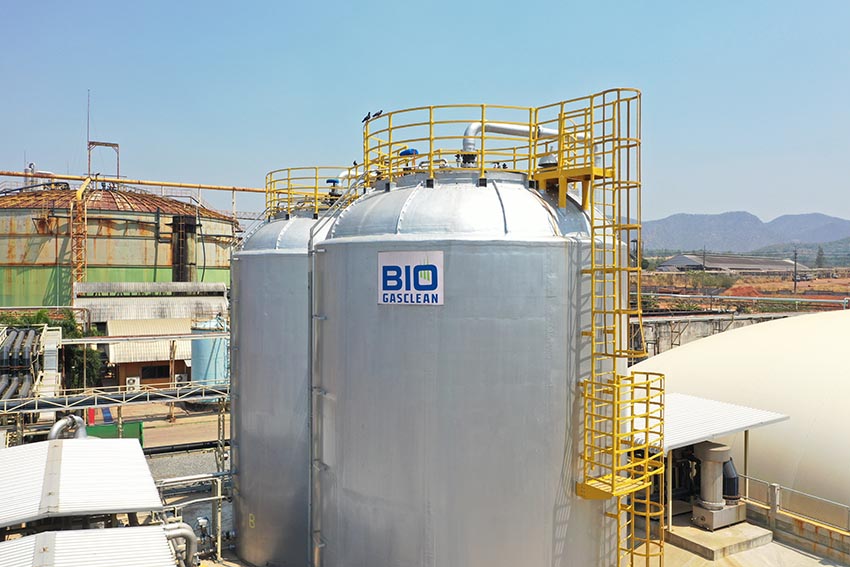Biogasclean is a Danish private owned corporation and is specialized in removal of sulfur from biogas without the use of chemicals. The company develops, manufactures and supplies fully automated gas cleaning systems for H2S removal combining low operating costs with high availability.
Biogasclean was founded in 2008 by Thorkil Dahlgreen and Peter Thygesen. In 2010 Søren Dolberg also became shareholder.
The company is located in Odense, Denmark’s 3rd largest city only 1½ hour drive from the international airport in Copenhagen. Production, sales and service in Southeast Asia is performed through the company’s subsidiary, Biogasclean (Thailand) Ltd., which is located in Bangkok, Thailand.
Biogasclean has +25 employees in Denmark, Thailand, Malaysia and Brazil. They have +285 references in operation or under construction in 40 countries. Their main markets are Denmark, Thailand, Malaysia, Indonesia and USA.
Easy Engineering: What are the main areas of activity of the company?
BIOGASCLEAN: Biogasclean supplies a full range of biological H2S removal systems.
We have developed two different technologies – biotrickling and MBR – and offer five different types of gas cleaners so it is possible to choose the best solution for your project. The gas cleaners can be designed to handle any flow and H2S content in the raw biogas and can be installed at greenfield projects or refurbishment of existing plants. Typically, the H2S is reduced to 50-250 ppm but Biogasclean can reduce to other values if required.

E.E: What’s the news for 2021 about new products?
BIOGASCLEAN: E-Fuel technology
Biogasclean is together with one of the world’s largest producers of biogas and two universities developing a Power-To-X project called E-Fuel. When completed E-Fuel will enable biogas plants – from the same amount of organic input – to increase their production of green gas by more than 60%!
The E-Fuel technology is based on the same technology we use for desulfurization, but with other bacteria and operating conditions. In the E-Fuel reactor CO2 and H2 is converted to CH4. Methane can substitute natural gas and be used for decentralized heat and power production or injected into the natural gas grid. Methane can also be compressed to Bio CNG for heavy trucks or cooled down and liquified to Bio LNG for ships. Furthermore, methane can be processed to green fuel for aircrafts and green plastic for the industry in a GLT (Gas-To-Liquid) plant.
The lowest hanging fruit is biogas plants where the biogas typically consists of 60% CH4 and 40% CO2. But the E-Fuel technology is not restricted to biogas plants only; it can be applied everywhere where you have a CO2 source.
While biogas production and the associated H2S removal is already an established and fast-growing industry methanation of CO2 (carbon dioxide) with H2 (hydrogen) to CH4 (methane) is still under development and not yet in commercial operation.

E.E: What are the ranges of products?
BIOGASCLEAN: Biogasclean has two different technologies for biological H2S removal systems.
Biotrickling – How it works
In a biotrickling filter the biogas is forced through one or more process tanks with a packing material. The microbes grow on the surface of the packing material forming a biofilm. The H2S in the biogas is transferred from the gas phase into the biofilm, where is used as energy source by the bacteria which oxidize H2S to sulfate and elemental sulfur.
The bacteria are aerobic; they require oxygen. Therefore, atmospheric air is injected into the raw biogas or the CO2 stream at the inlet to the process tank. The scrubber liquid is trickling down the packing material and provides moisture and nutrients for the bacteria. The temperature in the process tank is kept between 30 to 50°C (86 to 122°F). The effluent from the process is a liquid fertilizer which is discharged into the outflow from the anaerobic digester.
MBR – How it works
MBR – Moving Bed Reactor – is Biogasclean’s groundbreaking and patented technology for cleaning biogas with a high sulfur content. The MBR technology is especially developed for biogas generated on waste waters with high organic loads such as ethanol distilleries. The MBR has a very compact design and only requires 25-30% tank volume compared to biotrickling.
After compression, cooling and air injection the raw biogas with H2S is bubbled through one or more process tanks with liquid containing the moving MBR media. The MBR system is fully automated and is simple to operate and maintain, including cleaning of packing media.

E.E: What are the most innovative products marketed?
BIOGASCLEAN: Clearly the E-Fuel technology with the power-2-x segment.
E.E: What estimations do you have for 2021?
BIOGASCLEAN: We predict that the Biogas marked will grow globally, and especially in USA.

